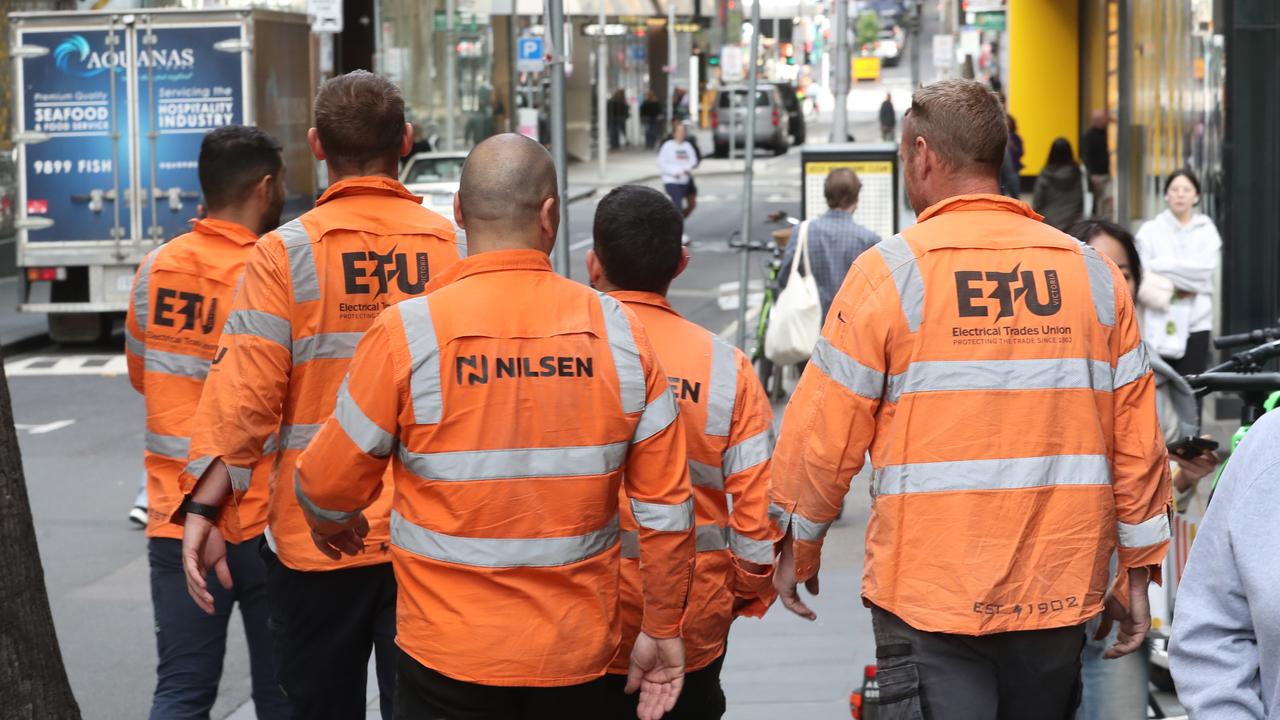Souring unemployment the latest sign of cooling jobs market
One economist has labelled a new set of figures as the “final nail in the coffin” for the chance of a rate hike next month.

Business Breaking News
Don't miss out on the headlines from Business Breaking News. Followed categories will be added to My News.
The jobless rate jumped higher to 3.7 per cent in July after the economy lost nearly 15,000 jobs in the latest sign that Australia’s red-hot labour market may be beginning to cool.
In good news for borrowers, the weaker jobs numbers are further evidence the Reserve Bank’s strategy to slow the economy may be working, with economists expecting that a further hike to the cash rate at its September meeting is increasingly unlikely.
The number of employed Australians fell by 14,600 in July, the latest figures from the Australian Bureau of Statistics showed, undershooting economists’ expectations that employment would instead increase by 15,000, up to 3.6 per cent.
The decrease was driven by a loss of 24,200 full-time jobs, but this figure was offset by an increase of 9600 part-time positions.

Oxford Economics Australia’s Ben Udy said the jobs numbers were likely the “final nail in the coffin” for the chance of a rate hike at the RBA’s meeting in September, but inflation had not fully retreated.
“The deterioration in the labour market has a long way to run before the RBA can completely relax,” Mr Udy said.
ANZ economists agreed that the central bank would keep rates steady at its next meeting, arguing that the data was aligned with the RBA’s view that the labour market may have peaked.
“There is no change to our RBA view off the back of these data, we see the cash rate on hold at 4.1 per cent for quite some time,” ANZ head of Australian economics Adam Boyton said.

ABS head of labour statistics Bjorn Jarvis said the winter school holidays break may have affected the July jobs numbers, and the fall in employment had come after monthly jobs growth averaged 42,000 through the six months to June 2023.
“July includes the school holidays, and we continue to see some changes around when people take their leave and start or leave a job,” Mr Jarvis said.
“It’s important to consider this when looking at month-to-month changes compared with the usual seasonal pattern. The only other fall in employment in 2023 was in April, which also included school holidays.”
The workforce participation rate eased slightly to 66.7 per cent, down from a record high reading of 66.9 per cent in May.

The underemployment rate – which measures the share of people in work but who are seeking additional hours – remained steady at 6.4 per cent.
The change in the jobless figures differed substantially across the country.
In Tasmania, the unemployment rate increased from 3.5 to 4.7 per cent, while in Western Australia, the unemployment fell 0.2 percentage points to 3.4 per cent.
The jobless rate increased to 3.3 per cent in NSW, which had previously experienced a record low unemployment rate of 2.9 per cent. However, in Victoria, unemployment fell 0.1 percentage points to 3.6 per cent.

As Australian workers face a cost of living crunch, the data revealed Australians were now picking up additional hours of work in order to shield themselves from soaring inflation.
Australians worked an extra 4 million hours in July despite 14,600 fewer people being in work.
The fresh figures follow Tuesday’s release of the minutes for the RBA’s August 1 meeting, at which the central bank held the cash rate steady at 4.1 per cent for a second consecutive month. The minutes revealed for the first time that the bank was concerned that Australia’s jobs market may have peaked.
“There were some signs that the labour market was at a turning point, including a small rise in the underemployment rate,” the minutes read.
“More generally, members noted signs that the substantial rise in interest rates over the prior year was constraining demand, including in the retail sector, where the value of sales had not grown for some time.
“Consumption had already slowed significantly, there were early signs that the labour market might be at a turning point and inflation was heading in the right direction.”

Despite 12 hikes to the cash rate since May last year, unemployment has remained incredibly resilient, with record job vacancies filled as Australia’s migration intake has surged past pre-pandemic levels. Unemployment has not risen past 3.7 per cent during this period.
Nevertheless, forecasters expect the jobless rate to increase in the months ahead.
Commonwealth Bank economist Belinda Allen said the labour market had been showing signs of deterioration since late 2022 and was now past its peak tightness.
“The labour market remains tight, but there are signs that conditions are loosening,” she said.
As the economy slows, the Reserve Bank predicts unemployment to increase to 4.5 per cent by mid-2025, meaning a further 140,000 Australians will be out of work.

With unemployment remaining at near-record low, nominal wages have risen to their highest levels in more than a decade. According to the latest wages data, released on Tuesday, salaries grew 3.6 per cent in the year to June.
But workers won’t be feeling any pay-rise in their pockets as high inflation continues to outpace wages growth. Employees have now experienced 12 consecutive quarters of real wage cuts, bringing purchasing power back to 2009 levels.
Speaking to Sky News, Treasurer Jim Chalmers despite global economic headwinds, the unemployment result was evidence of the “pretty remarkable” shape the Australian economy was in.
“We’ve created more jobs in the first year of the Albanese government than any new government on record,” he said.
“We never like to see the unemployment rate go up, but I think it’s something that people have been expecting for some time.”
Originally published as Souring unemployment the latest sign of cooling jobs market








